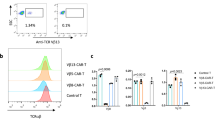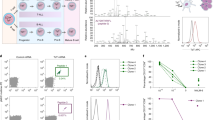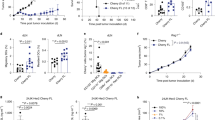Abstract
T cells can be directed to antigen-specific, MHC-independent target cell lysis by grafting with a recombinant receptor with antibody-like specificity. Here, we asked whether T cells from the peripheral blood of a patient with cutaneous T cell lymphoma can be recruited for an immune response against autologous tumor cells. Lymphoma cells with a CD3− CD4+ CD30+ phenotype and clonal TCR-Vβ7 rearrangement were isolated from a cutaneous lesion. The lymphoma lesion additionally harbored CD3+ CD25+ activated normal T cells despite ongoing tumor progression. Peripheral blood-derived T cells from the lymphoma patient were retrovirally engrafted with a recombinant anti-CD30-scFv-γ receptor. Upon cocultivation with autologous CD30+lymphoma cells, grafted T cells increase IFN-γ secretion and lyse specifically lymphoma cells with high efficiency, even at an effector to target cell ratio of as low as 1:20. Our data demonstrate that the recombinant anti-CD30-γ receptor overcomes T cell tolerance for tumor cells and directs T cells specifically against autologous lymphoma cells.
This is a preview of subscription content, access via your institution
Access options
Subscribe to this journal
Receive 12 print issues and online access
$259.00 per year
only $21.58 per issue
Buy this article
- Purchase on Springer Link
- Instant access to full article PDF
Prices may be subject to local taxes which are calculated during checkout




Similar content being viewed by others
References
Eshhar Z, Waks T, Gross G, Schindler DG . Specific activation and targeting of cytotoxic lymphocytes through chimeric single chains consisting of antibody-binding domains and the gamma or zeta subunits of the immunoglobulin and T-cell receptors Proc Natl Acad Sci USA 1993 90: 720–724
Hwu P et al. In vivo antitumor activity of T cells redirected with chimeric antibody/T cell receptor genes Cancer Res 1995 55: 3369–3373
Altenschmidt U, Klundt E, Groner B . Adoptive transfer of in vitro-targeted, activated T lymphocytes results in total tumor regression J Immunol 1997 159: 5509–5515
Abken H, Hombach A, Reinhold U, Ferrone S . Can combined T cell- and antibody-based immunotherapy outsmart tumor cells? Immunol Today 1998 19: 2–5
Willimsky G, Blankenstein T . Interleukin-7/B7.1-encoding adenoviruses induce rejection of transplanted but not nontransplanted tumors Cancer Res 2000 60: 685–692
Lee PP et al. Characterization of circulating T cells specific for tumor associated antigens in melanoma patients Nat Med 1999 5: 677–685
Lee KH et al. Increased vaccine-specific T cell frequency after peptide-based vaccination correlates with increased susceptibility to in vitro stimulation but does not lead to tumor regression J Immunol 1999 163: 6292–6300
Dürkop H et al. Molecular cloning and expression of a new member of the nerve growth factor receptor family that is characteristic for Hodgkin's disease Cell 1992 68: 421–427
Ellis TM et al. CD30 is a signal transducing molecule that defines a subset of human activated CD45RO+ T cells J Immunol 1993 151: 2380–2389
Amakawa R et al. Impaired negative selection of T cells in Hodgkin's disease antigen CD30-deficient mice Cell 1996 84: 551–562
Hombach A et al. A chimeric T cell receptor recognizing the CD30 antigen converts cytotoxic T cells to specificity for Hodgkin and Reed Stemberg cells Cancer Res 1998 58: 1116–1119
Willemze R et al. EORTC classification for primary cutaneous lymphomas: a proposal from the Cutaneous Lymphoma Study Group of the European Organization for Research and Treatment of Cancer Blood 1997 90: 354–371
Trefzer U et al. Hybrid cell vaccination for cancer immune therapy: first clinical trial with metastatic melanoma Int J Cancer 2000 85: 618–626
Hombach A et al. A chimeric receptor that selectively targets membrane-bound carcinoembryonic antigen (mCEA) in the presence of soluble CEA Gene Therapy 1999 6: 300–304
Hombach A et al. T cell activation by recombinant FcεRI γ-chain immune receptors: an extracellular spacer domain impairs antigen dependent T cell activation but not antigen-recognition Gene Therapy 2000 7: 1067–1075
Weijtens ME, Willemsen RA, Hart EH, Bolhuis RL . A retroviral vector system ‘STITCH’ in combination with an optimized single chain antibody chimeric receptor gene structure allows efficient gene transduction and expression in human T lymphocytes Gene Therapy 1998 5: 1195–1203
Pohl C et al. CD30 specific AB1-AB2-AB3 internal image antibody network: potential use as anti-idiotype vaccine against Hodgkin's lymphoma Int J Cancer 1993 54: 418–425
Bruynk A, Seemann G, Bosslet K . Charcterization of a humanized bispecific monoclonal antibody for cancer therapy Br J Cancer 1993 67: 436–440
Weijtens ME et al. Single chain Ig/gamma gene-redirected human T lymphocytes produce cytokines, specifically lyse tumor cells, and recycle lytic capacity J Immunol 1996 157: 836–843
Acknowledgements
We would like to thank Dr RL Bolhuis (Department of Clinical and Tumor Immunology, Daniel den Hoed Cancer Center, Rotterdam, The Netherlands) for providing us with the retroviral expression vector pSTITCH. This work is supported by grants from the Deutsche Forschungsgemeinschaft (DFG), Bonn, Germany, through SFB 502, the Deutsche Krebshilfe, Bonn, through 70–2235-Ab1 and 70–2091-Lu1, and the Köln Fortune Program.
Author information
Authors and Affiliations
Rights and permissions
About this article
Cite this article
Hombach, A., Muche, J., Gerken, M. et al. T cells engrafted with a recombinant anti-CD30 receptor target autologous CD30+ cutaneous lymphoma cells. Gene Ther 8, 891–895 (2001). https://doi.org/10.1038/sj.gt.3301467
Received:
Accepted:
Published:
Issue Date:
DOI: https://doi.org/10.1038/sj.gt.3301467
Keywords
This article is cited by
-
CAR-T cell potency: from structural elements to vector backbone components
Biomarker Research (2022)
-
Superior Therapeutic Index in Lymphoma Therapy: CD30+ CD34+ Hematopoietic Stem Cells Resist a Chimeric Antigen Receptor T-cell Attack
Molecular Therapy (2016)
-
Strategies to genetically engineer T cells for cancer immunotherapy
Cancer Immunology, Immunotherapy (2016)
-
Chimeric Antigen Receptors for Cancer: Progress and Challenges
Current Stem Cell Reports (2015)
-
Targeting of mesenchymal stem cells to ovarian tumors via an artificial receptor
Journal of Ovarian Research (2010)



